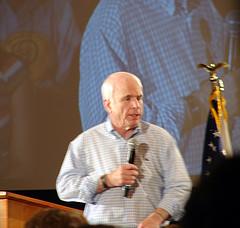|
|
|
Thursday, November 20th, 2008
 For a long time now I’ve believed that the L word in all its forms has been abused and corrupted and I’ve haven’t been shy about saying so. Further, I hate words that are defined using variations of themselves. When that happens there is nothing concrete against which to check the meaning of the word or its usage. For a long time now I’ve believed that the L word in all its forms has been abused and corrupted and I’ve haven’t been shy about saying so. Further, I hate words that are defined using variations of themselves. When that happens there is nothing concrete against which to check the meaning of the word or its usage.
I’m also not a lover of people who rant and whine about what’s wrong, but offer no ideas to fix the problem/situation.
So it’s time to start working on solutions.
Perhaps a new acronym would jump-start changing the career slant of ‘leader’.
That way we can offer leadership skills to all, so that they can indeed lead whenever it’s appropriate to the situation—leaders in the instance—instead of anointing a chosen few.
How about POF (person-out-front) to refer to someone at the front of the organization.
Or perhaps it would be better to use upper and lower case for the person in front who may or may not be a Leader, but is a leader.
For example, Richard Fuld is a leader, whereas Lou Gerstner is a Leader.
Of course, that may be worse, since people in those roles already consider themselves ‘special’ and might start thinking of the likeness between god and God.
That’s as far as I’ve gotten, but I’m hoping that y’all, AKA, my brilliant readers, will add your ideas and suggestions.
Together we can make a difference.
Your comments—priceless
Don’t miss a post, subscribe via RSS or EMAIL
Image credit: sxc.hu
Posted in About Leadership, Change, Communication, What Do You Think? | 4 Comments »
Tuesday, November 18th, 2008
By Wes Ball. Wes is a strategic innovation consultant and author of The Alpha Factor – a revolutionary new look at what really creates market dominance and self-sustaining success (Westlyn Publishing, 2008) and writes for Leadership Turn every Tuesday. See all his posts here. Wes can be reached at www.ballgroup.com.
 The government is changing its mind faster than a three year old. The government is changing its mind faster than a three year old.
No wonder the stock market is scared silly.
Let’s get this straight.
In an attempt to help more people gain “the American dream” of owning a home, the U.S. It even went so far as to set up organizations to help resell those loans, so the risk was spread around to unsuspecting investors.
Then, when it looks like some people are being irresponsible with this program, and actually putting people at risk of losing everything, the government says, “Oh, that’s really OK, because it is achieving the goal of putting more people in homes.”
Then, when it all collapses and a lot more than just the 6% of loans that were risky start to go bad, the government says, “Let’s buy up those bad assets and free up the credit markets.” Then, finally, just as the financial industry is starting to believe that perhaps there will be some stability and security ahead, the government changes its mind and decides to focus on consumers and saving a broad range of hurting companies instead, government put pressure on banks to loan money to people who really could not afford it.
Is it any wonder that the stock market is going through such wild swings? Can anyone blame corporate executives for being terrified? With the children running things, who can guess what’s next?
One thing is certain: leadership is supposed to provide vision and a sense of predictability and stability.
Can anyone call what we are seeing “leadership?”
Your comments—priceless
Don’t miss a post, subscribe via RSS or EMAIL
Image credit: sxc.hu
Posted in About Leadership, Leaders Who DON'T, Wes Ball | No Comments »
Saturday, November 15th, 2008
I had a recent conversation on the final post from a series last summer regarding supposed differences between ‘leaders’ and managers.
The reader said she was confused and asked whether managers needed to be ‘leaders’, too.
I think that my responses will be of use to others, so I’ve rounded them out below to increase access to the information.
 It would be lovely if there was a nice, clear-cut answer to the ‘leader’/manager thing, but like a lot of these types of questions it depends on whom you ask. It would be lovely if there was a nice, clear-cut answer to the ‘leader’/manager thing, but like a lot of these types of questions it depends on whom you ask.
There are two distinct schools of thought. One believes that leaders and managers are different and see ‘leaders’ as on a higher plane.
Others, like me, believe that to manage well requires having and using so-called leadership skills.
To further confuse the issue, there’s a growing movement that thinks leadership skills can and should be found at any/all levels of the organization (think organizational leadership) and become active as the need arises.
In other words, real leadership is what you believe and how you think and act, AKA, MAP, as opposed to your position.
Further, real leadership isn’t about style or even ‘vision’.
Style may change as you adopt a presentation appropriate to the people with whom you are interacting, but that stylistic change doesn’t change who you are and what you believe.
Vision presentation also changes based on your audience. Changes in the actual vision is a different subject
To summarize,
- While management is what you do, leadership is the way you think.
- Great management is composed of equal parts leadership and accountability.
- True leaders are proclaimed as such by those around them, not by themselves.
Your comments—priceless
Don’t miss a post, subscribe via RSS or EMAIL
Image credit: sxc.hu
Posted in About Leadership, Communication, Entrepreneurship, management, Personal Development, What Leaders DO | No Comments »
Friday, October 24th, 2008
I really dislike words that have no definition other than a different form of themselves.
Leader – a person or thing that leads.
Leadership – the position or function of a leader
Talk about something with no real meaning—except when looking at the man-hours spent teaching and writing about it or the hundreds of millions of dollars spent on acquiring it.
And I find the practice of identifying ‘leaders’ early in their careers particularly repugnant for two reasons.
1. The idea that you can identify future ‘leaders’ from their actions on the playground or in high school or during their initial working years is inaccurate at best and stupid at worst.
Those identified as kids are the ones who excel at getting noticed, love the spotlight, have a good story to tell and are typically attractive and mainstream. The nerds and misfits are rarely noticed as future ‘leaders’—think Steve Jobs.
Picking them out for special training during their first five years of work eliminates all those who work for bad bosses or for companies where entry level hires are grunts with no real responsibility.
Choosing them because they have an MBA is really ridiculous—all the degree proves is that they could afford grad school (either had the money or went into debt) and that they made it through. That’s it.
Further, the ‘early leader’ approach eliminates all those late bloomers giving them far less opportunities to excel.
The second reason is much worse.
2.Those ‘chosen’ start getting extra attention and mentoring from day one of being identified, so the traits that got them noticed get stronger. Stronger isn’t always better.
They are anointed, singled out for greatness, they are special.
Being special sets you apart; suddenly you’re better than the others and that means that there must be different rules for you because you’re special, better—and entitled. An attitude best summed up by Richard Nixon when he said, “When the President does it, that means that it is not illegal.”
And that sense of being anointed a ‘leader’ is partly responsible for the current debacle.
Your comments—priceless
Don’t miss a post, subscribe via RSS or EMAIL
Posted in About Leadership, Culture, Leadership Skills, Leading Stupidities, Personal Development | 7 Comments »
Saturday, October 18th, 2008
 The so-called leaders who, over decades, got us into our current economic mess did so because of their MAP (mindset, attitude, philosophy™); MAP that kept telling them that they were so brilliant that they knew best. The so-called leaders who, over decades, got us into our current economic mess did so because of their MAP (mindset, attitude, philosophy™); MAP that kept telling them that they were so brilliant that they knew best.
But as a wise man said, you can learn from everyone.
When I was growing up I had an aunt with whom I didn’t see eye to eye, to say the least. Yet, it was because of this aunt that I learned something that became a cornerstone of my MAP.
My aunt had a glass topped dressing table and, like many women of that era, she would place inspirational clippings and notes under the glass. That’s where I first saw
Profit from the mistakes of others—you don’t have time to make them all yourself.
As much sense as it makes, even back then, it’s been one of the hardest for me to follow. I seem to profit well from small and medium mistakes, but have an unhappy tendency to make the really large ones myself.
The same can be said for many of our business, financial and political ‘leaders’.
This isn’t the first economic crisis brought about in the name of profit and maximizing shareholder investment, just the worst in a long time.
As I read the news a line from the sixties hit “Where have all the flowers gone…” keeps repeating in my mind—“when will they ever learn, when will they ever learn?”
Your comments—priceless
Don’t miss a post, subscribe via RSS or EMAIL
Image credit
Posted in About Leadership, Ethics, Personal Development, What Leaders DO | No Comments »
Friday, October 10th, 2008
Wednesday Phil Gerbyshak over at Slacker Manager shared his application of Edward Brown’s description of the two dominant leadership models, Charismatic Leadership (often described as arousing the emotions of the populous through imagery and poetic prose) and Traditional Leadership (Often described as operations-centric and unilateral while courting consensus building) and analyzed Obama and McCain in that light.
I thought I’d add to that with a guest post from Korn/Ferry International’s Kevin Cashman and Ken Brousseau (detailed bios at end of post), in which they apply their CEO assessment, expertise and constructs to the Presidential candidates.
Note: The candidates are discussed in random order and reflects no preference by the authors.
An Expert Analysis Of Our Presidential Candidates’ Executive Leadership
 
Voters commonly cast their ballots based on the critical issues and policies, but what about the equally crucial assessment of a candidate’s leadership strengths and approaches?
- Who is the leader beneath the speeches, policies and ads?
- How would experts describe the unique leadership styles of Barrack Obama and John McCain if they were being assessed for a global CEO position?
Two leadership authorities from one of the world’s largest talent management firms, Korn/Ferry International, point to four critical and differentiating facets of Obama and McCain’s leadership:
- decision-making styles;
- emotional temperaments;
- learning agility; and
- power-of-voice versus power-of-connection.
Overall, Cashman and Brousseau say that
- McCain’s strengths appear to be action-orientation, adherence to principle and a fiery tenacity to achieving results, whereas
- Obama tends to demonstrate exceptional learning agility, collaboration and is calmer under pressure.
1. Decision-Making Styles – Cashman and Brousseau assert that both candidates are principled decision-makers, but differ in their propensities to quickly or analytically make decisions and hone in on single versus multiple courses of action. Korn/Ferry’s research (see this Harvard Business Review article) at shows that those unable to lead in a “complex style” have low likelihoods of succeeding in their positions, yet once they’ve risen to a top level, it’s possible to succeed with multiple approaches. They observe:
- McCain is a more uni-focused thinker who focuses on one key principle or goal and tenaciously holds to a particular action rather than changing positions. When not in action-mode, he shifts to a more complex style that’s both analytic and uni-focused, efficiently studying the facts, and making and sticking to what he senses is the best decision.
- Obama also operates in the complex mode, but more often uses a creative and integrative style that is analytic and more open to alternate possibilities. Before making a judgment, he studies an extensive array of information and options, then gradually forms a strategy combining multiple objectives, actions and viewpoints.
2. Emotional Temperaments – The ability to manage the emotions of one’s self and those around them is a defining aspect of leadership at any level.
- When principles are challenged or threatened, McCain seems to be more emotive and combative to win the day. Achieving high performance works best for him in a high-octane pace where things are very active.
- Obama tends to maintain equanimity and gets introspective to sort out the best solutions to win, asking his staff to provide him with some reflective time each day. His high performance is achieved by reflecting, synthesizing and collaborating.
3. Leadership Agility and Ability to Deal with Ambiguity -The key leadership competency in shortest supply is the ability to deal with ambiguity, according to the research of Korn/Ferry and others and supported by past Presidents who’ve described the job as “everything happening all at once.” Though we often dub political leaders who change their positions as wishy-washy, Cashman and Brousseau say that can be a sign of agility, as good leaders summon past lessons and observations to reframe thinking in first-time contexts or changing global environments. Agility – found to be much more predictive of potential and success than raw intelligence – has components related to mental, people, results and change.
- Obama demonstrates exceptional mental agility and has proclivity for dealing with change and people, but critics may question if his results agility on a large-scale have been sufficiently demonstrated.
- McCain, in contrast, shows a strong results orientation and a measure of mental agility, but his history of working amid volatility and commitment to tradition may call his agility with people and change into question.
4. Exerting Power-of-Voice or Power-of-Connection – Cashman and Brousseau say that many leaders can be understood as either heroic leaders who assert their power-of-voice or more interpersonally inclined leaders who employ power-of-connection. The key is being able to exercise the weaker, non-default area. According to research by Zenger and Folkman, leaders who excel in people or results only, reach the 90th percentile of leadership effectiveness nine or 13 percent of the time, but those who possess both reach that level of success in two-thirds of instances.
- McCain, as someone who forcefully asserts for results, best typifies the heroic “I” type of leader, who leverages personal influence to impact results. The downside can be too much drive and not enough relational connection.
- Obama and his collaborative approach characterize “We” leaders, who leverage collaboration, relationship and synergy to get results. In crisis situations, however, sometimes more “I” is required.
The leadership experts say Obama fits the overall archetype of a “magician” leader, someone who blends ideas and people to produce new solutions to unsolved problems.
McCain, on the other hand, is more of the traditional “warrior” leader, bringing about results through force of will or assertion with little fear of adversarial relationships or situations.
I’m no expert, but it seems to me that we’re more in need of a magician who “blends ideas to produce new solutions” than a warrior who applies “force of will.”
It seems to me that most of the “leaders” who crashed their companies on the rocks, as well as the current Administration, either are, or have a strong leaning towards, the warrior model.
I’m tired of “I” leaders proclaiming their visions, unwilling to brook any kind of disagreement.
I (we?) can only hope that the calamities we’re facing foster a stronger application of “we”—in both politics and business
About the authors:
Kevin Cashman, author of the newly expanded book Leadership from the Inside Out , founded LeaderSource, a Minneapolis-based international leadership development, executive coaching and team effectiveness consultancy that joined with Korn/Ferry International in 2006. Leadership from the Inside Out, available in second edition in September, was named the #1 best-selling business book of 2000 by CEO-READ and one of the top 20 best-selling business books of the decade. Over the past 25+ years, Cashman and his team have coached thousands of senior executives and teams to enhance performance. , founded LeaderSource, a Minneapolis-based international leadership development, executive coaching and team effectiveness consultancy that joined with Korn/Ferry International in 2006. Leadership from the Inside Out, available in second edition in September, was named the #1 best-selling business book of 2000 by CEO-READ and one of the top 20 best-selling business books of the decade. Over the past 25+ years, Cashman and his team have coached thousands of senior executives and teams to enhance performance.
Kenneth Brousseau, Ph.D., is CEO and co-founder of Decision Dynamics LLC, a firm specializing in behavior profiling and human resource systems design. Prior to forming Decision Dynamics, he served as a management and organization professor at the University of Southern California Graduate School of Business Administration. Dr. Brousseau specializes in behavioral assessment systems for purposes of employee selection, organizational development and career management. He is coauthor of The Dynamic Decision Maker, and he has authored articles on career development, work system design, team development and organizational design in publications such as Harvard Business Review, the Journal of Applied Psychology and the Academy of Management Executive.
Your comments—priceless
Don’t miss a post, subscribe via RSS or EMAIL
Image credit: Obama, McCain
Posted in About Leadership, Change, Communication, Culture, Followers, Leadership Skills, Leading Factors, management, Politics | 3 Comments »
Friday, October 3rd, 2008
 Leadership, oh leadership. Wherefore art thou, oh leadership?What does this list have in common? Leadership, oh leadership. Wherefore art thou, oh leadership?What does this list have in common?
Leadership. Each person on this list has been held up as an example of leadership; lauded by the gurus of leadership for their vision, skill at articulating it and ability to attract followers.
- Alan Fishman, Washington Mutual
- Angelo Mozilo, Countrywide
- Bruce Karatz, KB Homes
- Chuck Prince Citigroup
- Douglas Ivester, Coca-Cola
- Frank Newman, Bankers Trust
- Franklin Raines Fannie Mae
- Gregory Parseghian, Freddie Mac
- Hank McKinnell, Pfizer
- James Cayne, Bear Stearns
- John Mack, Morgan Stanley
- Ken Thompson, Wachovia
- Kerry Killiger, Washington Mututal
- Lloyd Blankfein, Goldman
- Michael Ovitz, Disney
- Philip Purcell, Morgan Stanley
- Richard Fuld, Lehman
- Richard Grasso, New York Stock Exchange
- Robert Nardelli, Home Depot
- Stanley O’Neal, Merril Lynch
- Stephen Hilbert, Conseco
What else does this list have in common? Over the last 5 years every one of them has been ousted from their role.
The majority of their visions helped architect the current financial mess.
Oh yeah, and their parachutes ranged from gold to diamond-encrusted platinum. (Payouts listed here and here)
Take me to your leader.
Your comments—priceless
Don’t miss a post, subscribe via RSS or EMAIL
Image credit: greyman CC license
Posted in About Leadership, Communication, Culture, Ethics, Leaders Who DON'T, Leading Factors | 1 Comment »
Friday, September 26th, 2008
 I’ve never been a big believer in the cult of individual leadership, a subject brilliantly discussed at Managing Leadership.The current economic meltdown is brought to you by the same folks who have been lauded for years for their extraordinary leadership. I’ve never been a big believer in the cult of individual leadership, a subject brilliantly discussed at Managing Leadership.The current economic meltdown is brought to you by the same folks who have been lauded for years for their extraordinary leadership.
Nor do I believe that leadership is positional; true leadership is found at all levels—it comes forward and makes itself felt when need arises.
Of course, that rarely happens, since most organizations subscribe to the tenets of individual and positional leadership.
CEOs are praised for their brilliant leadership during good times and condemned for not producing the same results in economic downturns.
Worse, their results are compared to predecessor’s performance during heady economic expansion—an environment in which it takes far less skill to produce profits.
It’s said that leadership requires vision and all these leaders had visions—unfortunately. They had visions of being the biggest, baddest, richest corporation in their field—and they were lauded for that vision.
It will be interesting to watch leadership gurus roll out the disclaimers and disavow the same folks who they’ve held up as examples of how to lead.
Your comments—priceless
Don’t miss a post, subscribe via RSS or EMAIL
Image credit: izzyplante CC license
Posted in About Leadership, Ethics, Leaders Who DON'T | No Comments »
Wednesday, September 17th, 2008

Don’t miss my other WW: the key to accomplishing anything
Your comments—priceless
Don’t miss a post, subscribe via RSS or EMAIL
Image credit: Louchiere CC license
Posted in Leadership Skills, management, Personal Development, Wordless Wednesday | No Comments »
Saturday, September 13th, 2008
 The terms ‘leader’ and ‘leadership’ are bandied about constantly, but nowhere more often than in politics, especially during elections. The terms ‘leader’ and ‘leadership’ are bandied about constantly, but nowhere more often than in politics, especially during elections.
But did you know that nearly five thousand years ago a Chinese philosopher proved that truly great leadership couldn’t exist in the political arena?
Not true, I hear many of you say.
OK, first, consider three generally acknowledged descriptions of true leadership by Lao Tse in the Tao Te Ching . .
- Be gentle and you can be bold; be frugal and you can be liberal; avoid putting yourself before others and you can become a leader among men.
- The superior leader gets things done with very little motion. He imparts instruction not through many words but through a few deeds. He keeps informed about everything but interferes hardly at all. He is a catalyst, and though things would not get done well if he weren’t there, when they succeed he takes no credit. And because he takes no credit, credit never leaves him.
- As for the best leaders,the people do not notice their existence.
The next best,
the people honor and praise.
The next, the people fear;
and the next, the people hate—
When the best leader’s work is done,
the people say, “We did it ourselves!”
To lead the people, walk behind them.
Now name for me just one politician who comes even close to fitting these descriptions.
Sadly, the oxymoronic coupling of ‘leader’ and ‘politician’ usually is just plain moronic.
Your comments—priceless
Don’t miss a post, subscribe via RSS or EMAIL
Image credit: Patti CC license
Posted in About Leadership, Followers, Just For Fun, Leadership Skills, Politics | 4 Comments »
|
 Subscribe to
Subscribe to
MAPping Company Success
About Miki 
Clarify your exec summary, website, etc.
Have a quick question or just want to chat? Feel free to write or call me at 360.335.8054
The 12 Ingredients of a Fillable Req
CheatSheet for InterviewERS
CheatSheet for InterviewEEs™
Give your mind a rest. Here are 4 quick ways to get rid of kinks, break a logjam or juice your creativity!
Creative mousing
Bubblewrap!
Animal innovation
Brain teaser
The latest disaster is here at home; donate to the East Coast recovery efforts now!
Text REDCROSS to 90999 to make a $10 donation or call 00.733.2767. $10 really really does make a difference and you'll never miss it.
And always donate what you can whenever you can
The following accept cash and in-kind donations: Doctors Without Borders, UNICEF, Red Cross, World Food Program, Save the Children
*/
?>About Miki
About KG
Clarify your exec summary, website, marketing collateral, etc.
Have a question or just want to chat @ no cost? Feel free to write
Download useful assistance now.
Entrepreneurs face difficulties that are hard for most people to imagine, let alone understand. You can find anonymous help and connections that do understand at 7 cups of tea.
Crises never end.
$10 really does make a difference and you’ll never miss it,
while $10 a month has exponential power.
Always donate what you can whenever you can.
The following accept cash and in-kind donations:
|
 For a long time now I’ve believed that the L word in all its forms has been abused and corrupted and I’ve haven’t been shy about saying so. Further, I hate words that are defined using variations of themselves. When that happens there is nothing concrete against which to check the meaning of the word or its usage.
For a long time now I’ve believed that the L word in all its forms has been abused and corrupted and I’ve haven’t been shy about saying so. Further, I hate words that are defined using variations of themselves. When that happens there is nothing concrete against which to check the meaning of the word or its usage.



 The government is changing its mind faster than a three year old.
The government is changing its mind faster than a three year old. It would be lovely if there was a nice, clear-cut answer to the ‘leader’/manager thing, but like a lot of these types of questions it depends on whom you ask.
It would be lovely if there was a nice, clear-cut answer to the ‘leader’/manager thing, but like a lot of these types of questions it depends on whom you ask. The so-called leaders who, over decades, got us into our current economic mess did so because of their
The so-called leaders who, over decades, got us into our current economic mess did so because of their 

 Leadership, oh leadership. Wherefore art thou, oh leadership?What does this list have in common?
Leadership, oh leadership. Wherefore art thou, oh leadership?What does this list have in common? I’ve never been a big believer in the cult of individual leadership, a subject brilliantly discussed at
I’ve never been a big believer in the cult of individual leadership, a subject brilliantly discussed at 
 The terms ‘leader’ and ‘leadership’ are bandied about constantly, but nowhere more often than in politics, especially during elections.
The terms ‘leader’ and ‘leadership’ are bandied about constantly, but nowhere more often than in politics, especially during elections.
